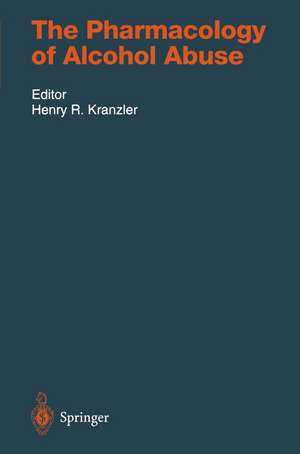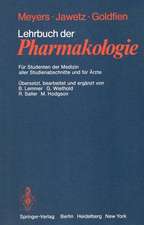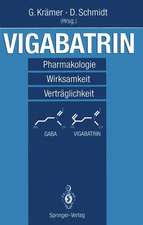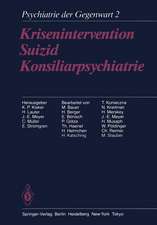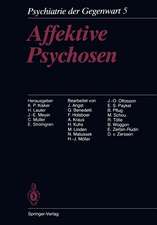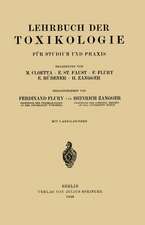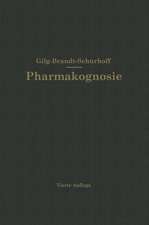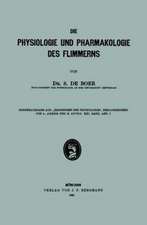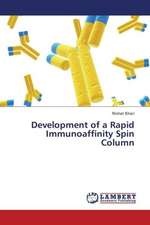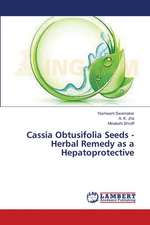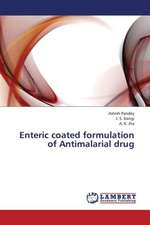The Pharmacology of Alcohol Abuse: Handbook of Experimental Pharmacology, cartea 114
Editat de Henry R. Kranzler Contribuţii de R.F. Anton, H.C. Becker, B.J. Berg, M.J. Bohn, K.E. Bremner, D.A. Ciraulo, R.K. Fuller, J. Gelernter, K A Grant, D. Hersh, G.A. Higgins, P.L. Hoffman, C.M. Knapp, A.Dzung Le, S.W. Leslie, R.Z. Litten, J. Littleton, P. Manu, A.T. McLellan, A.K. Mehta, J. Moring, C. Müller, C. A. Naranjo, M.K. Romach, H. Rommelspacher, H.H. Samson, B. F. Sands, E.M. Sellers, W.J. Shoemaker, M.K. Ticku, D.M. Tomkins, J.R. Volpicelli, N.T. Watson, T.M. Worneren Limba Engleză Paperback – 16 dec 2011
Din seria Handbook of Experimental Pharmacology
- 5%
 Preț: 3517.78 lei
Preț: 3517.78 lei - 5%
 Preț: 1425.97 lei
Preț: 1425.97 lei - 5%
 Preț: 1435.28 lei
Preț: 1435.28 lei - 5%
 Preț: 1430.52 lei
Preț: 1430.52 lei - 5%
 Preț: 1930.69 lei
Preț: 1930.69 lei - 5%
 Preț: 1922.47 lei
Preț: 1922.47 lei - 5%
 Preț: 1937.46 lei
Preț: 1937.46 lei - 5%
 Preț: 2117.58 lei
Preț: 2117.58 lei - 5%
 Preț: 2119.96 lei
Preț: 2119.96 lei - 5%
 Preț: 2117.38 lei
Preț: 2117.38 lei - 5%
 Preț: 1088.15 lei
Preț: 1088.15 lei - 5%
 Preț: 1098.27 lei
Preț: 1098.27 lei - 5%
 Preț: 1420.29 lei
Preț: 1420.29 lei - 5%
 Preț: 1104.84 lei
Preț: 1104.84 lei - 5%
 Preț: 1104.84 lei
Preț: 1104.84 lei - 5%
 Preț: 1108.14 lei
Preț: 1108.14 lei - 5%
 Preț: 1106.69 lei
Preț: 1106.69 lei - 5%
 Preț: 1105.77 lei
Preț: 1105.77 lei - 5%
 Preț: 1174.35 lei
Preț: 1174.35 lei - 5%
 Preț: 408.48 lei
Preț: 408.48 lei - 5%
 Preț: 409.63 lei
Preț: 409.63 lei - 5%
 Preț: 539.89 lei
Preț: 539.89 lei - 5%
 Preț: 720.47 lei
Preț: 720.47 lei - 5%
 Preț: 733.09 lei
Preț: 733.09 lei - 5%
 Preț: 731.27 lei
Preț: 731.27 lei - 5%
 Preț: 746.43 lei
Preț: 746.43 lei - 5%
 Preț: 747.72 lei
Preț: 747.72 lei - 5%
 Preț: 725.24 lei
Preț: 725.24 lei - 5%
 Preț: 742.80 lei
Preț: 742.80 lei - 5%
 Preț: 393.23 lei
Preț: 393.23 lei - 5%
 Preț: 735.66 lei
Preț: 735.66 lei - 5%
 Preț: 728.33 lei
Preț: 728.33 lei - 5%
 Preț: 389.52 lei
Preț: 389.52 lei - 5%
 Preț: 730.71 lei
Preț: 730.71 lei - 5%
 Preț: 740.58 lei
Preț: 740.58 lei - 5%
 Preț: 730.19 lei
Preț: 730.19 lei - 5%
 Preț: 723.42 lei
Preț: 723.42 lei - 5%
 Preț: 726.68 lei
Preț: 726.68 lei - 5%
 Preț: 3516.49 lei
Preț: 3516.49 lei - 5%
 Preț: 729.26 lei
Preț: 729.26 lei - 5%
 Preț: 737.11 lei
Preț: 737.11 lei - 5%
 Preț: 730.92 lei
Preț: 730.92 lei - 5%
 Preț: 738.78 lei
Preț: 738.78 lei - 5%
 Preț: 909.94 lei
Preț: 909.94 lei - 5%
 Preț: 720.10 lei
Preț: 720.10 lei - 5%
 Preț: 734.74 lei
Preț: 734.74 lei - 5%
 Preț: 727.80 lei
Preț: 727.80 lei - 5%
 Preț: 3513.38 lei
Preț: 3513.38 lei
Preț: 731.27 lei
Preț vechi: 769.77 lei
-5% Nou
Puncte Express: 1097
Preț estimativ în valută:
139.94€ • 145.27$ • 116.69£
139.94€ • 145.27$ • 116.69£
Carte tipărită la comandă
Livrare economică 25 martie-08 aprilie
Preluare comenzi: 021 569.72.76
Specificații
ISBN-13: 9783642784378
ISBN-10: 3642784372
Pagini: 580
Ilustrații: XXVI, 548 p.
Dimensiuni: 155 x 235 x 30 mm
Greutate: 0.8 kg
Ediția:Softcover reprint of the original 1st ed. 1995
Editura: Springer Berlin, Heidelberg
Colecția Springer
Seria Handbook of Experimental Pharmacology
Locul publicării:Berlin, Heidelberg, Germany
ISBN-10: 3642784372
Pagini: 580
Ilustrații: XXVI, 548 p.
Dimensiuni: 155 x 235 x 30 mm
Greutate: 0.8 kg
Ediția:Softcover reprint of the original 1st ed. 1995
Editura: Springer Berlin, Heidelberg
Colecția Springer
Seria Handbook of Experimental Pharmacology
Locul publicării:Berlin, Heidelberg, Germany
Public țintă
ResearchCuprins
1 The Pharmacology of Alcohol Abuse: An Introduction.- References.- 2 Alcohol-Induced Changes in Neuronal Membranes.- A. Introduction.- B. Historical Overview.- I. The Meyer-Overton Hypothesis.- II. Membrane Disorder.- C. Membrane Lipid Effects.- I. Disordering of Membranes by Acute Ethanol.- II. Partitioning of Ethanol into Membranes.- III. Pressure Reversal of Acute Effects of Ethanol.- IV. Membrane Lipid Composition Changes Due to Chronic Ethanol Exposure.- 1. Phospholipids.- 2. Cholesterol.- 3. Acyl Chain Composition.- 4. Do Lipid Composition Changes Cause Tolerance or Change Membrane Function?.- V. Effects of Ethanol on Membrane Lipid Domains.- 1. Lipid Classes.- 2. Transbilayer Lipid Distribution.- 3. Annular Lipids.- 4. Lateral Membrane Domains.- VI. Ethanol-Induced Hypothermia.- VII. Lipid Effects on Proteins.- D. Membrane Protein Effects.- I. Direct Effects of Acute Ethanol on Proteins.- 1. Firefly Luciferase.- 2. The GABAa Receptor.- II. Protein Model of the Anesthetic Cutoff Effect.- III. Effects of Ethanol on Calcium Channels.- IV. Effects of Ethanol on Intracellular Calcium.- V. Effects of Ethanol on G-Protein-Related Systems.- 1. Acute Effects on Protein Kinase C.- 2. The Adenylyl Cyclase System.- 3. Chronic Effects.- VI. Effects of Chronic Ethanol on Receptor Subunit Expression.- 1. The GABAa Receptor.- 2. Origin of mRNA Effects.- E. Conclusions.- References.- 3 Effects of Ethanol on Voltage-Dependent Calcium Channel Function.- A. Voltage-Dependent Calcium Channels.- I. Introduction.- II. L Type Channels.- III. N, P, and T Type Channels.- 1. Conclusions.- B. Effects of Ethanol and Other Sedative-Hypnotic Drugs on Voltage-Dependent Calcium Channels.- I. Ethanol Effects on Ion Channels.- II. Ethanol Effects on Different Types of Calcium Channel.- III. BrainRegional Differences in the Effects of Ethanol.- IV. Chronic Ethanol Effects on Calcium Channels.- V. Calcium Channel Blockers and Ethanol Preference.- VI. Conclusions.- C. Effects of Barbiturates and Benzodiazepines on Calcium Channels.- I. Conclusions.- References.- 4 Effects of Alcohol on Excitatory Amino Acid Receptor Function.- A. Introduction.- I. Site of Action of Ethanol: Protein Versus Lipid.- B. Ethanol and Excitatory Amino Acid Receptors.- I. Characteristics of Glutamate Receptors.- II. Ethanol and NMD A Receptor Function: Acute Effects.- 1. Mechanism of Action of Ethanol.- 2. Effects of Anesthetics and Sedative Hypnotics.- 3. Ethanol and the NMD A Receptor In Vivo.- 4. Ethanol and the NMDA Receptor in Development.- III. Ethanol and NMDA Receptor Function: Chronic Effects.- 1. Role of NMDA Receptors in Ethanol Withdrawal (Physical Dependence).- 2. Role of NMDA Receptors in Ethanol Tolerance.- 3. Role of NMDA Receptors in Opiate Tolerance and Dependence.- C. Summary: Ethanol and the NMDA Receptor.- References.- 5 Effects of Alcohol on GABA-Mediated Neurotransmission.- A. Introduction.- B. Behavioral Studies.- C. Binding Studies.- D. Functional Studies.- I. Electrophysiological Studies.- II. Chloride Flux.- E. Rol5-4513: Ethanol Antagonist.- F. Molecular Biological Studies.- G. Chronic Ethanol Treatment and GABA Receptor Gene Expression.- H. Conclusions.- References.- 6 Involvement of CNS Catecholamines in Alcohol Self-Administration, Tolerance, and Dependence: Preclinical Studies.- A. Introduction.- B. Acute Effects of Investigator-Administered Ethanol: Potential for Catecholamine Involvement in Ethanol Reinforcement.- I. Norepinephrine.- II. Dopamine.- C. Oral Ethanol Seif-Administration in Nonoperant Situations.- I. Limited Access Ethanol Drinking Situations.- 1. Norepinephrine.- 2. Dopamine.- II. Continuous Access Ethanol Drinking Situations.- 1. Norepinephrine.- 2. Dopamine.- III. Operant Paradigms of Oral Ethanol Self-Administration.- 1. Norepinephrine.- 2. Dopamine.- D. Chronic Effects of Ethanol on Noradrenergic and Dopaminergic Activity.- I. Norepinephrine.- II. Dopamine.- E. Role of Catecholamines in Ethanol Tolerance and Physical Dependence.- I. Tolerance.- II. Physical Dependence.- F. Summary.- References.- 7 5-HT Mediation of Alcohol Self-Administration, Tolerance, and Dependence: Pre-Clinical Studies.- A. Introduction.- B. Overview of the 5-HT System: Morphology and Receptors.- C. 5-HT and Alcohol Self-Administration.- I. Increasing 5-HT Function.- 1. Indirect 5-HT Agonists and Alcohol Self-Administration.- 2. 5-HT Receptor Agonists and Alcohol Self-Administration.- 3. Treatments that Enhance 5-HT Function and Other Consummatory Behaviours.- 4. Treatments that Enhance 5-HT Function and Other Drug-Reinforced Behaviour.- II. Reducing 5-HT Function.- 1. 5-HT Receptor Antagonists and Alcohol Self-Administration.- 2. 5-HT Lesions and Alcohol Self-Administration.- 3. Treatments that Reduce 5-HT Function and Other Consummatory Behaviours.- 4. Treatments that Reduce 5-HT Function and Other Drug-Reinforced Behaviour.- III. Biochemical Factors.- IV. Summary.- D. 5-HT, Alcohol Tolerance, and Physical Dependence.- I. General Aspects of Alcohol Tolerance.- 1. Definition and Classification.- 2. Features of Ethanol Tolerance.- II. Role of 5-HT in Ethanol Tolerance/Dependence.- III. Differences in 5-HT Regulation of Ethanol Drinking and Ethanol Tolerance.- IV. 5-HT and Ethanol Dependence.- E. Effects of Chronic Ethanol Administration on 5-HT Receptors.- I. Intoxication.- F. Interaction of 5-HT and Opioids.- G. General Summary.- References.- 8 Opioid Mediation of Alcohol Self-Administration: Pre-Clinical Studies.- A. Introduction.- B. Alcohol Drinking Enhances Opioid System Activity.- I. Opioid Peptides Are Produced in the Metabolism of Alcohol (TIQ Alkaloid Hypothesis).- II. Alcohol Drinking Leads to Changes in Opioid Receptor Sensitivity.- III. Alcohol Drinking Leads to the Release of Endogenous Opioids.- C. Genetic Susceptibility to Alcohol Abuse.- D. Modulating Opiate Receptor Activity Influences Alcohol Drinking.- I. Low Doses of Opioids Increase Alcohol Drinking.- II. Moderate to High Doses of Opioids Suppress Alcohol Drinking.- III. Alcohol Drinking Increases During Opiate Withdrawal.- E. Uncontrollable Stress and Alcohol Abuse.- I. Post-Stress Alcohol Drinking.- F. Opiate Antagonists Attenuate Alcohol Drinking.- I. Why Do Organisms Abuse Alcohol?.- G. Summary.- References.- 9 Animal Models of the Alcohol Addiction Process.- A. Introduction.- B. Alcohol-Seeking Behavior.- C. Initiation.- I. Models to Assess Environmental Effects in the Initiation of Alcohol-Seeking.- II. Models to Assess the Genetic Basis of Initiation of Alcohol-Seeking.- III. Models to Assess the Psychopharmacological Basis of Initiation of Alcohol-Seeking.- D. Transition to Abuse and Dependence (Maintenance).- I. Role of Tolerance in the Maintenance of Excessive Alcohol-Seeking.- II. Role of Sensitization in the Maintenance of Excessive Alcohol-Seeking.- III. Role of Dependence in the Maintenance of Excessive Alcohol-Seeking.- IV. Role of Environmental Interactions in the Maintenance of Excessive Alcohol-Seeking Behavior.- V. Role of Conditioned Effects in the Maintenance of Excessive Alcohol-Seeking Behavior.- E. Remission/Treatment.- I. Nonpharmacological Treatments to Reduce Alcohol Consumption.- II. Pharmacological Treatments to Reduce Alcohol Consumption.- F. Relapse.- I. Role of Conditioned Withdrawal in the Relapse Process.- II. Role of Conditioned Drug-Like Effects in the Relapse Process.- G. Summary.- References.- 10 Ethanol and Neurohormonal Regulation.- A. Effects of Ethanol on Neurohormones.- I. Hypothalamic-Pituitary-Gonadal Axis.- 1. Gonadotropin-Releasing Hormone Secretion.- 2. Gonadotropin Secretion.- 3. Gonadal Endocrine Secretion.- 4. Gonadal Steroid Metabolism.- 5. Consequences of Alterations in the HPG Axis.- 6. Hypothalamic-Pituitary-Gonadal Axis and Fetal Development.- 7. Conclusions.- II. Hypothalamic-Pituitary-Adrenal Axis.- 1. Corticotropin-Releasing Hormone Secretion.- 2. Adrenocorticotropic Hormone Secretion.- 3. Adrenal Steroids.- 4. Consequences of Alterations in the HPA Axis.- 5. Hypothalamic-Pituitary-Adrenal Axis and Fetal Development.- 6. Conclusions.- III. Hypothalamic-Pituitary-Thyroid Axis.- 1. Thyrotropin-Releasing Hormone and TSH Secretion.- 2. Thyroid Hormones.- 3. Consequences of Alterations in the HPT Axis.- 4. Conclusions.- IV. Other Neurohormonal Systems.- 1. Growth Hormone.- B. Role of Neurohormonal Alterations in Ethanol Consumption.- I. Opioid Peptides.- II. Hypothalamic-Pituitary-Adrenal Axis.- III. Appetitive Systems.- C. Overall Conclusions.- References.- 11 Clinical Application of Findings from Animal Research on Alcohol Self-Administration and Dependence.- A. Overview.- B. Alcohol Consumption.- I. Clinical Aspects of Alcoholism.- II. Animal Models of Alcoholism.- 1. Self-Administration.- 2. Drug Discrimination.- 3. Genetic Strains.- III. Preclinical Studies.- 1. Serotonin.- 2. Opioids.- 3. Dopamine.- IV. Clinical Studies.- 1. Serotonin.- 2. Opioids.- 3. Dopamine.- C. Alcohol Withdrawal.- I. Preclinical Studies.- II. Clinical Studies.- D. Comorbidity.- I. Overview.- II. Animal Models.- III. Clinical Studies.- 1. Depression.- 2. Anxiety.- E. Conclusions.- References.- 12 Genetic Factors in Alcoholism: Evidence and Implications.- A. Introduction.- B. Clinical Studies: Familial Patterns in Alcohol Use.- I. Adoption Studies.- II. Twin Studies.- III. Other Clinical Data Bearing on Genetics.- IV. Trait Markers and Differences Between Familial and Nonfamilial Alcoholism.- C. Laboratory Studies: Search for a Molecular Basis for a Complex Behavior.- I. Linkage Studies.- II. Association Studies.- 1. Alcohol-Metabolizing Enzymes.- 2. D2 Dopamine Receptor Gene.- D. Conclusions.- References.- 13 Pharmacotherapy and Pathophysiology of Alcohol Withdrawal.- A. Introduction.- B. Clinical Syndrome.- I. Phenomenology and Description.- II. Drinking Variables Related to the Alcohol Withdrawal Syndrome.- III. Protracted Alcohol Withdrawal.- IV. Psychiatric Comorbidity and Alcohol Withdrawal.- C. Pathophysiology of Alcohol Dependence and Withdrawal.- I. GABA-A Receptor System.- II. NMDA Receptor System.- III. Voltage-Operated Calcium Channels.- IV. Monoamine Systems.- V. Second Messenger Systems and Adenosine.- VI. Summary.- D. Repeated Episodes of Alcohol Withdrawal: The “Kindling” Hypothesis.- E. Treatment of Alcohol Withdrawal.- F. Measurement of the Alcohol Withdrawal Syndrome.- G. Nonpharmacologic Treatment of Alcohol Withdrawal.- H. Pharmacologic Treatment.- I. Complicated Alcohol Withdrawal.- II. Uncomplicated Alcohol Withdrawal.- III. Benzodiazapines.- IV. Alpha- and Beta-Adrenergic Blockers.- V. Anticonvulsants.- VI. Miscellaneous Treatments.- I. Treatment of Alcohol Withdrawal Seizures.- J. Biologic Aspects of Alcohol Withdrawal in Man.- References.- 14 Drugs to Decrease Alchol Consumption in Humans:Aversive Agents.- A. Introduction.- B. Absorption, Metabolism, and Excretion.- C. Pharmacokinetics.- D. Mechanism of Disulfiram: Ethanol Reaction.- E. Clinical Use.- F. Efficacy.- G. Enhancing Disulfiram Compliance.- H. Toxicity.- I. Contraindications to Disulfiram Treatment.- J. Calcium Carbamide.- K. Future Research Directions.- References.- 15 Drugs Attenuating Alcohol Consumption in Humans Through Effects on Various Neurotransmitter Systems.- A. Introduction.- B. Serotonin.- C. Dopamine.- D. Opioids.- E. Medications Acting on Other Neurotransmitter Systems.- F. Conclusions.- References.- 16 Pharmacology of Gastrointestinal Comorbidity in Alcoholics.- A. Introduction.- B. Drug Therapy for Alcohol-Induced Liver Disease.- I. Steatosis.- II. Alcoholic Hepatitis.- 1. Insulin and Glucagon.- 2. Corticosteroids.- 3. Anabolic Steroids.- 4. Colchicine.- 5. Propylthiouracil.- III. Cirrhosis.- 1. Ascites.- 2. Encephalopathy.- 3. Esophageal Varices.- IV. Liver Transplantation.- C. Drug Therapy of Acute Alcoholic Pancreatitis.- 1. Cimetidine.- 2. Somatostatin.- 3. Pirenzepine.- D. Drug Therapy of Chronic Alcoholic Gastritis.- E. Summary.- References.- 17 Drugs for the Treatment of Psychiatric Comorbidity in Alcoholics: Recent Developments.- A. Introduction.- B. Depression.- I. Assessment.- II. Treatment.- III. Pharmacotherapy.- 1. Cyclic Antidepressants.- 2. Monoamine Oxidase Inhibitors.- 3. Serotonin Uptake Inhibitors.- 4. Lithium.- C. Anxiety Disorders.- I. Assessment.- II. Treatment.- III. Pharmacotherapy.- D. Bipolar Affective Disorder.- I. Assessment.- II. Treatment.- III. Pharmacotherapy.- E. Schizophrenia.- I. Assessment.- II. Treatment.- III. Pharmacologic Treatment.- F. Conclusions.- References.- 18 Clinical Markers of Alcohol Abuse.- A. Introduction.- I. Definition ofthe Term “Marker”.- B. Ethanol, Acetaldehyde, and Acetate.- I. Ethanol.- II. Acetaldehyde.- III. Acetaldehyde-Hemoglobin Adduct.- IV. Acetate.- C. Monoamine Oxidase.- I. Regulation of Enzyme Activity.- II. In Vitro Effects of Ethanol.- III. Enzyme Activity in Alcoholics and Nonalcoholics.- IV. In Vitro Studies of Platelets from Alcoholics.- D. Guanine Nucleotide Binding Proteins and Adenylylcyclase.- I. Acute Effects of Ethanol.- II. Chronic Effects of Ethanol.- E. Serum Enzymes.- I. ?-Glutamyltransferase.- II. Aspartate Aminotransferase.- III. Other Enzymes, Indices, and Test Combinations.- F. Tetrahydroisoquinolines and ?-Carbolines.- I. Tetrahydroisoquinolines.- II. ?-Carbolines.- G. Immune System.- I. Blood Groups.- II. Immunoglobulins.- III. Human Leukocyte Antigens.- IV. Cell-Mediated Immune Function.- H. Alcohol Intake and Serum Trace Elements.- I. Trace Elements and Electrolytes.- II. Thiamine (Vitamin B1).- I. Carbohydrate-Deficient Transferrin.- I. Biochemistry.- II. Methodological Approaches.- III. Performance: Sensitivity and Specificity.- J. Conclusion.- References.- 19 Interaction of Alcohol with Therapeutic Drugs and Drugs of Abuse.- A. Introduction.- B. Pharmacokinetic Mechanisms.- I. Bioavailability and Absorption.- II. Distribution.- III. Metabolism.- C. Pharmacodynamic Mechanisms.- D. Individual Drugs.- I. Acetaminophen.- II. Angiotensin-Converting Enzyme Inhibitors.- 1. Enalapril.- III. Anticonvulsants.- 1. Phenytoin.- IV. Antidepressants.- 1. Amitriptyline.- 2. Imipramine.- 3. Clomipramine.- 4. Desipramine.- 5. Doxepin.- 6. Nortriptyline.- V. Serotonin Selective Reuptake Inhibitors.- VI. Antipyrine.- VII. Ascorbic Acid.- VIII. Barbiturates.- 1. Phenobarbital.- 2. Pentobarbital.- IX. Benzodiazepines.- 1. Chlordiazepoxide.- 2. Diazepam.- 3.Flurazepam.- 4. Lorazepam.- 5. Triazolam.- X. Bromocriptine.- XI. Ca2+ Blockers.- 1. Nifedipine.- 2. Nimodipine.- 3. Verapamil.- XII. Cannabis.- XIII. Cocaine.- XIV. Sodium Warfarin.- XV. Cromoglycate.- XVI. Disulfiram.- XVII. H2 Blockers.- 1. Cimetidine.- 2. Famotidine.- 3. Ranitidine.- XVIIII. Lithium carbonate.- XIX. Methylxanthines.- 1. Caffeine.- 2. Theophylline.- XX. Metoclopramide.- XXI. Neuroleptics.- 1. Chlorpromazine.- 2. Remoxipride.- 3. Thioridazine.- XXII. Nitrates.- 1. Nitroglycerin.- XXIII. Opioids.- 1. Methadone.- 2. Propoxyphene.- XXIV. Oral Contraceptives.- XXV. Oral Hypoglycemics.- 1. Chlorpropramide.- 2. Tolbutamide.- XXVI. Sedative-Hypnotics.- 1. Chloral Hydrate.- 2. Glutethimide.- 3. Meprobamate.- XXVII. Salicylates.- XXVIII. Tobacco.- References.- 20 Pharmacotherapies for Alcoholism: Theoretical and Methodological Perspectives.- A. Pharmacologic Approaches to Relapse Prevention in Alcoholics.- B. Treatment Matching.- I. Matching Based Upon Comorbid Psychopathology.- 1. Anxiety and Alcoholism.- 2. Depression and Alcoholism.- II. Matching Based Upon Other Patient Characteristics.- 1. Cloninger’s Typology.- 2. The “Type A/Type B” Distinction of Babor and Colleagues.- C. Methodologic Issues in Clinical Trials with Alcoholics.- I. Patient Assessment and Outcome Measurement: “For Whom Is One Drink Too Many?”.- II. Treatment Retention and “How Much Additional Treatment Is Too Much Treatment?”.- 1. Preventing Attrition.- 2. Analysis of Outcomes When Attrition Occurs.- III. Maximizing Compliance and Determining “How Well You’ve Done”.- IV. “How Long to Treat? Then What?”.- D. What May the Future Hold?.- References.
